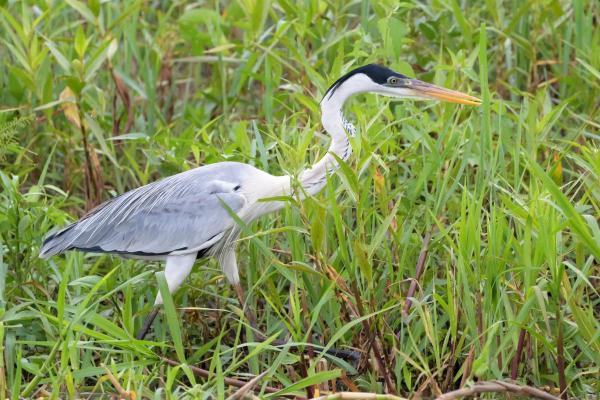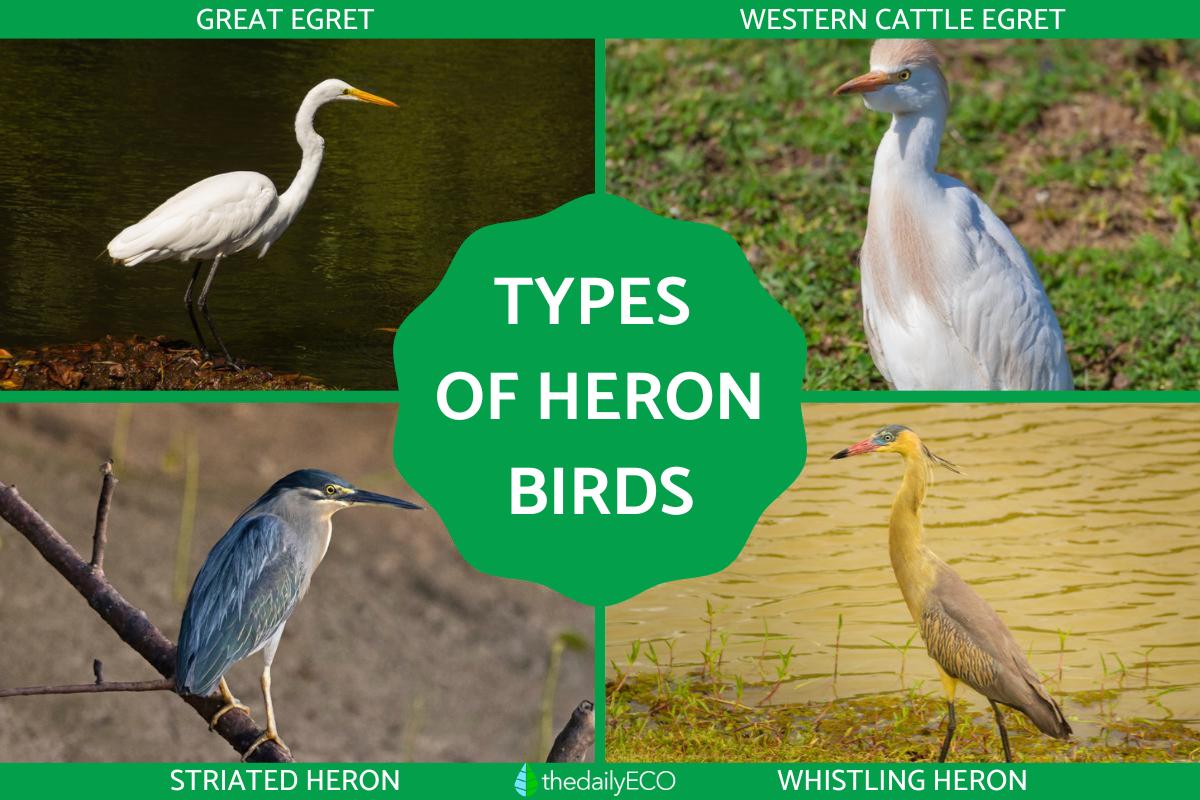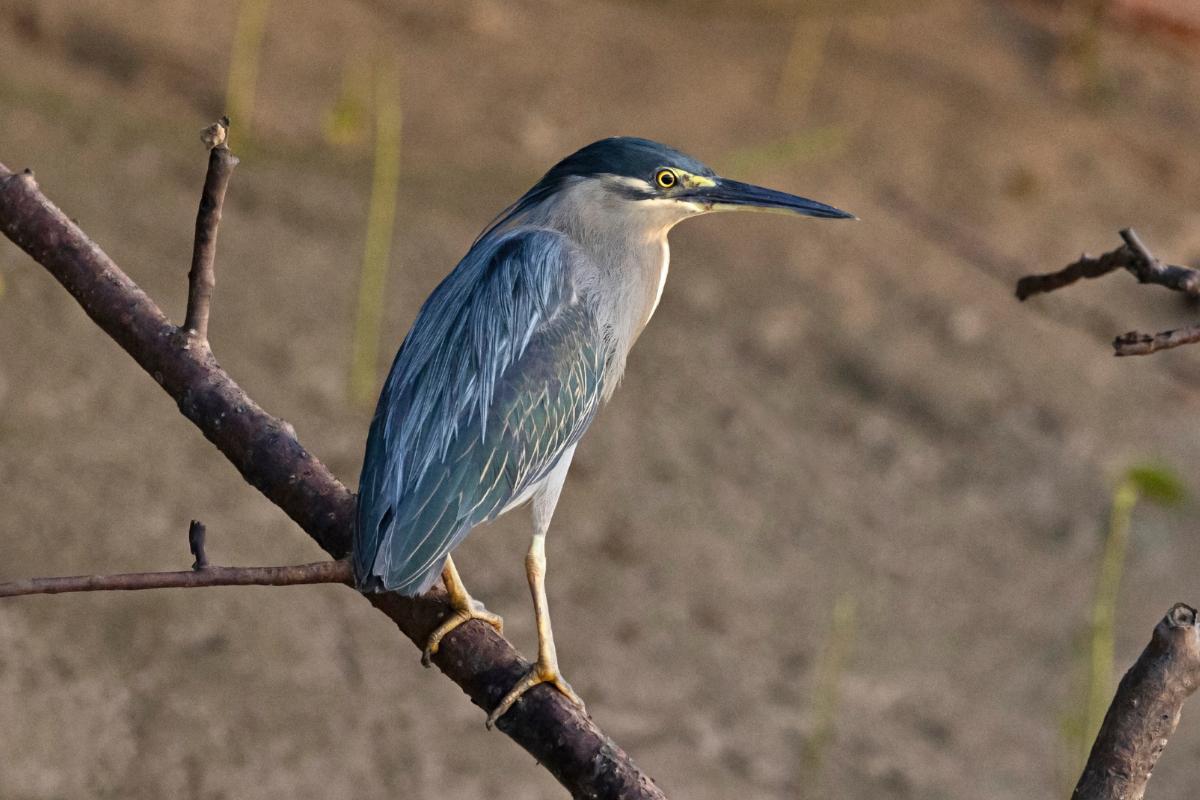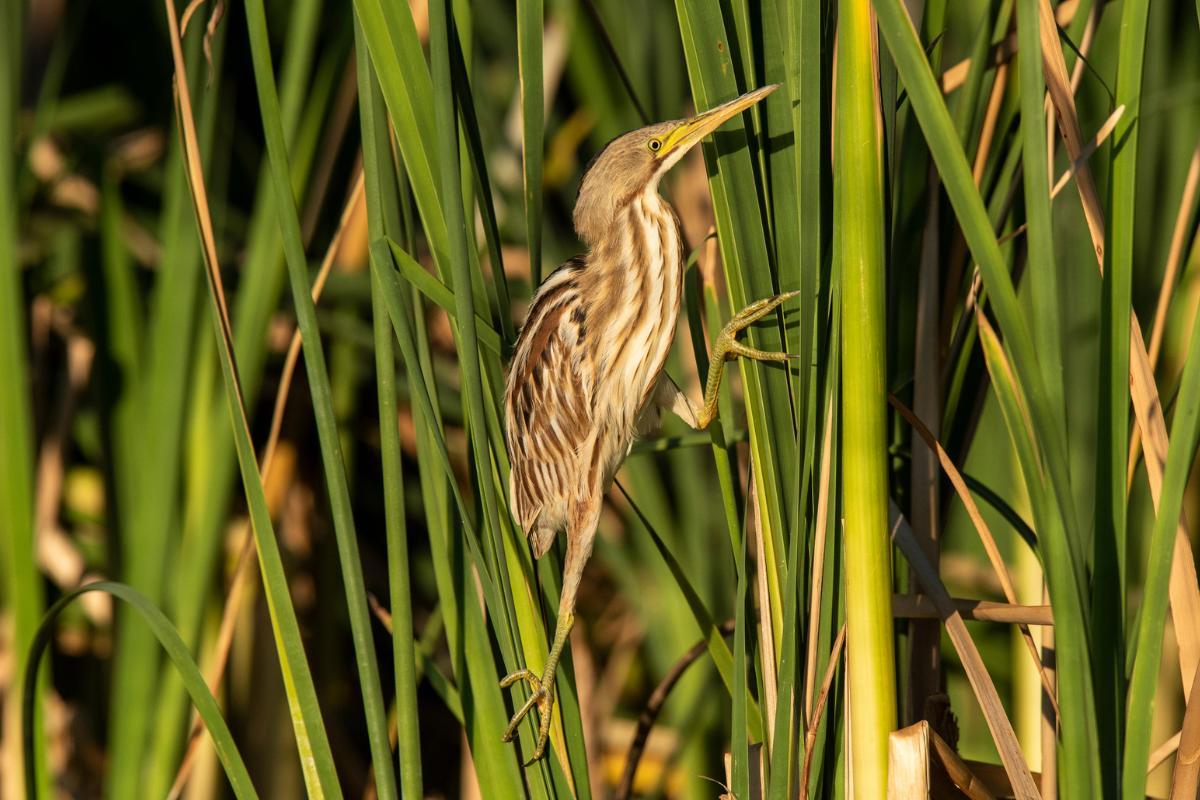Types of Heron Birds


Herons are aquatic bird species which make up the family Ardeidae. Although morphology can differ according to species, there are some defining characteristics of herons. These include long legs, necks and bills with all herons being relatively tall birds. Their broad wings allow them to fly steadily, something which has helped with the extensive migratory patterns of certain heron species. Egrets and bitterns are types of heron. Their distinctions are that egrets have predominately white feathers and bitterns tend to be slightly stockier. Bitterns do also have long necks, but they often keep them retracted to give them a hunched appearance. thedailyECO shares 10 types of heron birds with photos so you can see the diversity of these birds for yourself.
- Cocoi heron
- Great egret
- Black-crowned night heron
- Western cattle egret
- Snowy egret
- Striated heron
- Stripe-backed bittern
- Pinnated bittern
- Rufescent tiger heron
- Whistling heron
Cocoi heron
Native to Central and South America, the cocoi heron (Ardea cocoi) has grey-white plumage with characteristic long feathers on the nape, back and chest. Its beak is yellow, but the legs can vary from grey to pink in color. The largest South American heron species, it is diurnal and generally solitary, although it can form small groups.
Cocoi herons live in both freshwater and brackish water wetlands. They usually perch on trees and nest among thick vegetation or in grasslands. Nest formation uses dry sticks intertwined with other plant material, allowing them to lay between 3 and 5 light blue eggs during breeding season. It feeds on insects, amphibians, mammals, birds and fish.

Great egret
Egrets are herons which tend to have predominately white plumage, but they remain types of heron. This can be seen in the example of the great egret (Ardea alba) which is also known as the great white heron. As the name suggests, it is a large and slender heron. Its plumage is white, legs are black and beak is orange-yellow.
It is a type of solitary heron and is usually seen in calm, shallow bodies of water where it feeds on invertebrates, fish and amphibians. It is skillful at using its beak as a harpoon, retracting its s-shaped neck to strike with force. The great egret is one of the most widely distributed heron species, since it occupies all continents except Antarctica.

Black-crowned night heron
Night herons belong to various genera in the family Ardeidae. They are characterized by being stockier than most other herons with their name referring to the fact they tend to feed more at night. In addition to having a slightly more hunched appearance, they have s shorter and thicker beak. You can use the photo below to compare this with other types of herons.
As seen in the photo, the black-crowned night heron (Nycticorax nycticorax) is lead in color with a black crown, nape and back. They also have a white throat and two long white feathers on the back of the neck. It is nocturnal and crepuscular, living on the coasts of lakes, lagoons and rivers, both in humid forests and steppes. It prefers coasts with dense vegetation. Its diet is based on small vertebrates and invertebrates and plant remains and seeds. It has a wide distribution in Eurasia, Africa and America.

Western cattle egret
As with other egrets, the western cattle egret (Ardea ibis) is mainly white, but also has golden feathers on its head and neck during the breeding season. It inhabits almost all tropical, subtropical and temperate regions of the world, found in savannas, grasslands, mangroves, swamps, agricultural areas and reservoirs. The bill is black when they are juvenile, but this turns orange as they age.
It often perches on livestock, the reason for its common name. They can also be found on the ground, in trees and on manmade structures. It is small to medium-sized, reaching 16"/40 cm in height. It feeds on small vertebrates and invertebrates. A curiosity of this species is that its notable expansion and settlement to distant areas during the 20th century. This has led it to becoming an invasive species in certain regions.
See how the cattle egret's bill compares to the other different types of bird beaks with our related article.

Snowy egret
Another type of heron which is considered an egret, the snowy egret (Egretta thula) also has a white plumage, along with very distinctive black legs and yellow feet. Similar black and yellow markings can be seen on their bill. Their white feathers are elongated on the back and chest during the breeding season. These characteristics clearly distinguish them from the great egret. They are also considerably smaller.
Snowy egrets can be seen alone or forming flocks. When breeding, males build a suitable nest and try to entice females with a mating display that use distinct movements and calls. Its diet is based on fish, amphibians, arachnids, insects and crustaceans. It is native to the American continent where it lives in ponds, marshes, estuaries, lagoons, islands, streams and rivers.

Striated heron
The Striated heron (Butorides striata) is also known as the mangrove heron or little green heron. It is a species that lives in America, Asia, Africa and Oceania, both in brackish and freshwater environments. Adults can reach up to 19" (48 cm) in length. It feeds on fish and small insects with its long beak. Its crown and crest are greenish black, hence some of their common names. The front of the neck and chest are ochre brown.
This type of heron is known as being rather sedentary and patient. From the side of a body of water, they pounce on small fish, frogs and insects. They are also know to go fishing. By taking a piece of previously caught prey, they can lure fresh prey.

Stripe-backed bittern
The first heron bird species on our list which is commonly known as a bittern, the Stripe-backed bittern (Botaurus involucris) is native to South America. It is small in size, with a characteristic striped plumage of black, ochre and cinnamon.
Unlike other most other types of herons, it is difficult to observe and its flights are very short. It prefers estuaries and lagoons with dense reed beds or cattails. It feeds on fish, insects and amphibians. Its nesting is very particular, as it makes a conical platform of dry reeds where it lays 3 to 4 green eggs. Despite being difficult to observe, they are considered of least concern in terms of conservation. While hard to see, they are often observed thanks to their distinctive low-pitched vocalizations.
Read more general background as we explain how birds reproduce.

Pinnated bittern
Also known as the South American bittern, the pinnated bittern (Botaurus pinnatus) is a heron that inhabits tropical America. It is usually found in areas with tall grasses or reeds, very rarely venturing into open areas.
It is solitary, large and, as the photo depicts, has cryptic, light brown plumage with a mottled pattern of brown spots. It is a patient and agile hunter that feeds on fish, insects, amphibians and small mammals, including young common marmosets (Callithrix jacchus). It builds its cup-shaped nests with coarse plant material near water, where it lays 2 to 3 elliptical and olive-colored eggs per breeding season.

Rufescent tiger heron
Widely distributed throughout Central and South America, the rufescent tiger heron (Tigrisoma lineatum) lives in environments close to waterways with abundant vegetation. It is a type of heron with one of the most beautiful and distinctive plumages which can be seen in the photo below.
This plumage displays a brown neck and mottled black and white plumage. They have feathers with vermiculations, i.e. worm-like repeated patterns. These are present from the chin to the chest, although they appear all over the body of juveniles. It is a solitary species that moves slowly. It nests in trees or in reed beds, forming a platform of sticks or rushes where it lays 2 to 3 whitish eggs. It feeds on insects, fish, reptiles and crustaceans.

Whistling heron
The whistling heron (Syrigma sibilatrix) is a type of heron species with a pink-violet beak which is tipped in black. Its legs are also black and the iris is greyish white. This is a very showy heron with its grey/back dorsal plumage turning to light blue with a yellowish neck and chest.
Whistling herons generally travel in pairs and sometimes form groups of up to 45 specimens, making it a more social heron species. It sleeps in trees. Their vocalizations consist of a long whistle and a hoarse sound. It lives in puddles, swamps, meadows, rural areas and on the edges of mountains. It nests in trees, making a platform of sticks in which to rest.
Now you know some of the different types of herons we can find in the world, you may be interested to discover more about another type of water bird with our guide to the different types of ducks in nature.

If you want to read similar articles to Types of Heron Birds, we recommend you visit our Wild animals category.
- National Parks Administration. (n.d.). Biodiversity Information System.
https://sib.gob.ar/portada - National University of Litoral, Faculty of Veterinary Sciences. (2025). “Argentine Birds. Bird Families”.
https://www.fcv.unl.edu.ar/aves/















